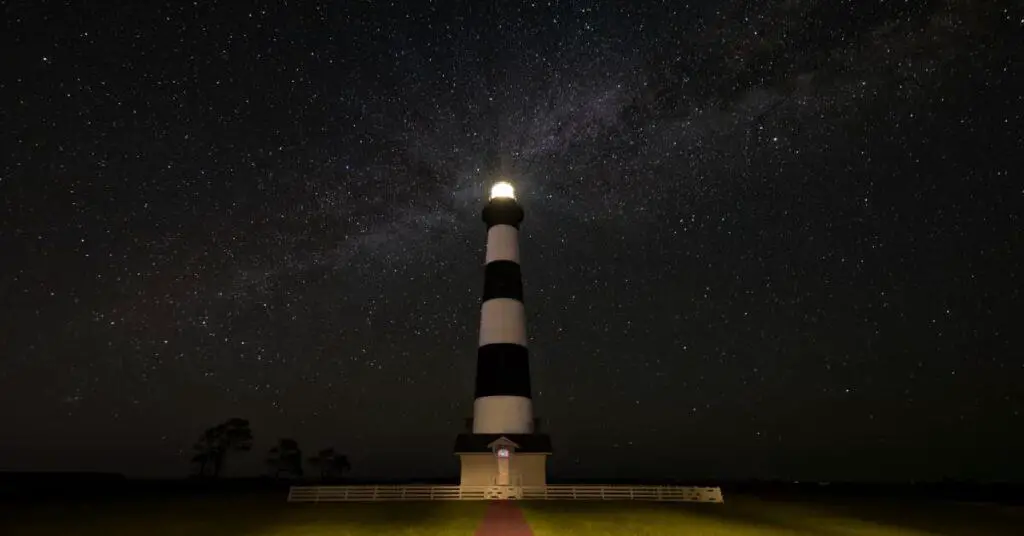Menu
Menu

Being eligible for the National Register of Historic Places. Bodie Island lighthouse has a rich history of trials and tribulations that all should see. With its uses and survival during the times of the Civil War, and both World War I and II. This historic site is one to see for years to come during the summer months.
The location of the Bodie Lighthouse is considered to be at the end of Cape Hatteras National Seashore.
According to the National Park Service, in 1837 the government sent Lieutenant Napoleon L. Coste to examine the coastline for a few potential spots for lighthouses. He noticed that the southbound ships needed one near Bodie island. That way they could fix their position.
The Bodie Island Lighthouse stood south of the Oregon Inlet on Pea Island, an area that is now underwater due to the migration of the inlet. However, the first lighthouse was built in 1847 after approval from congress. But it was soon abandoned twelve years later.
That same year, 1859, the second lighthouse was built but was unfortunately destroyed in 1861 during the civil war by fleeing confederate soldiers. As it was used as a lookout point for the Union.
In 1872, the third and most recent lighthouse was built with the original order of a Fresnel lens and was finished in 1872, eleven years after the second was destroyed.
It’s a composite compact lens that was created by physicist Augustin-Jean Fresnel. It’s known today as the invention that saved a million ships.
In 1932 the lighthouse was upgraded to an electric lamp that used oil to generate power. Yet, by 1953, it was transferred to The National Park Service for care, which was staffed until the year 1940, when the lighthouse was still automated.
Fast forward to 1953 and the power was switched from the generators, which were disconnected, to a power supplied from the commercial grid in the state.
It’s been reported that some people pronounce the name Bodie with a long “o” sound. Even though it’s pronounced as body, the stories are believed to be about the number of sailors who died when their ship was wrecked and was washed ashore along the east coast. The name given was called the “Graveyard of the Atlantic.”
Yet, it was not true, and it was that the name, Bodie, originated from the Body family that once owned the land in the year 1811.
It has been recorded that various ships have sunk due to storms, and German U-boats during World War I and World War II. Due to this, local gift shops in the area have been known to sell maps of where the shipwrecks are found.
Years would go by until a fundraiser was created to help restore the lighthouse to a historic site for all to see. After many years of raising the funds and dealing with postponements, work to restore the cast iron and other parts of the lighthouse started in August 2009.
In March of 2010, the scaffold was completed while the interior was only halfway finished. Unfortunately, restoration had to stop when issues were found around the support beams for the balcony. Making the project too expensive to finish.
One year later, things got worse when Hurricane Irene hit the shores of North Carolina where some of the restorations were damaged, which included a newly restored lantern room. As well as destroying a shroud that was covering the room.
Soon after the hurricane passed, more funds were secured to restart restoration in the year 2012 and were finished in March of 2013. There was a ceremony held to relight Bodie lighthouse on April 18, 2013. Soon the lighthouse was open for the public to climb the Bodie.
Bodie Island Lighthouse is available during the summer. With safety rules in place, the public can go and climb the lighthouse to take in the sights. Some of these rules are:
• Each climber must be at least 42 inches tall and climb on their own.
• Children 11 years old or younger must be accompanied by an adult 16 years or older.
• No person may not be lifted/carried
• No running, jumping, or stomping on stairs.
• Shoes required
• No pets allowed.
• No food or drink (except water)
The Bodie Island lighthouse has a little over 200 steps, which are equal to climbing a ten-story building. With the narrow stairs having only one side and nine landings. It is said that the lighthouse has no air conditioning and can be humid and hot while inside.
The Tour is not recommended for people with heart or respiratory problems.
With its rich history and tremendous stories of survival and restoration. Bodie Island lighthouse is a tour that you should take if you’re in the area.